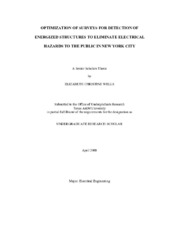| dc.description.abstract | There have been many reports of individuals and animals in New York City coming in contact with electrically energized structures caused by “stray voltage”. The electric utility, Consolidated Edison (Con Ed), has been working hard to drive down the exposure rate of the public to dangerous electrical conditions by completing manual and mobile scans, or surveys, of above ground structures and repairing those structures once found. Con Ed engineers and external experts are researching ways to reduce the number of shock incidents.
This thesis presents an analysis of Con Ed’s past manual and mobile scans, or surveys, in order to determine the number of annual scans needed to drive down the exposure rate. Three methods of analyzing this data are discussed. First, there is an examination of the relationship between the scans and the number of energized structures and then the relationship between the detection of energized structures and the number of shock incidents. Next, a sensitivity analysis of the time of year of each scan is performed to determine whether climatic changes directly affect the number, frequency, or duration of stray voltage incidents. Two types of stray voltages are considered when examining the data: manifest and intermittent. The final analysis compares the actual data from surveys to three models of intermittent stray voltage to analyze the behavior of the stray voltage occurrences.
Three major conclusions are drawn. First, it is determined that the efficiency of energized structure detection is proportional to the duration of scans. In terms of cost and efficiency, fewer scans with longer durations would be more beneficial. Second, the generation rate is fairly constant throughout the seasons, indicating that the weather does not affect the generation rate. Lastly, the analysis reveals that the efficiency of energized structure detection is proportional to an increase in the duty cycle of intermittency due to annual conditions. The number of energized structures increases in the early spring and decreases in the winter. It would be more efficient in terms of cost and time to bias scanning toward the spring months and limit scanning in the winter months. | en |


